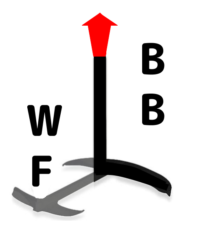In my last post I introduced the concept of a single number that would better represent your equipment’s ability to lift and keep your board out of the water than simply the area of your wing. After some research, consulting with my expert friend John York and consideration, I’ve settled on a formula that I believe will serve us well. My thanks also go to the people who answered my call and submitted their favorite equipment setup combinations. Their data helped me test different formula constant values to arrive at the final number.
The formula is simply:
L = 500 * W / R + F / R
Where L = Lift potential number, R = rider weight in kilograms, W = wing area in square meters and F = front foil area in square centimeters.
“L” calculator
Enter the following information to calculate your wing foiling equipment’s lift to weight ratio by the following beta test formula: W/R * 500 + F/R:
OR
The combined lift to weight ratio, “L” potential is:
Personal “L” tabulation tool
I have created a Google spreadsheet that you can make a copy of for your own use. It calculates the “L” values for every combination of wing and front foil that you use and displays them in a table for quick reference. I have tested it on my Android phone as well as in a browser and both work well. You can make a copy two ways:
- If you have a Google account and wish to use the tool as a Google sheet:
- Click this link and use the menu pick File -> Make a copy
- Choose a filename and location in your Google drive and click the “Make a copy” button.
- If you want to use the tool with some other spreadsheet app such as Apple Numbers for iPhone or Excel:
- Click this link and use the menu pick File -> Download -> Microsoft Excel.
- Save the file and use it with the app of your choice on your computer or phone.
To use your copy of the tool, go to the Equipment tab (sheet). Enter your weight and each of the front foils and wings you use. Note that only the name of each will display in the labels on the “L” table, so include the wing size and all the front foil information that you want displayed. Go to the “L” tab (sheet) to see the “L” values table.
If you go on to read the rest of this post, you will see some examples of the “L” value people needed for a given wind range. But we will need to start using the formula to gain more experience with this. The riders ability is a huge factor anyway, so you will learn over time what “L” value you need if your friend with better or lesser skills from yourself tells you the “L” value of their set up.
How I settled on the 500 constant number
The goals for the formula dictated use of the simple “sum of ratios” be used. Anything else would be too complicated. The only question was the constant factor. John assured me that even though the relationships involved required integral calculous to describe accurately, a linear equation would suffice well enough.
First of all, I knew that the contributions to the final “L” number from the wing and foil should at least be in the same order of magnitude. So I knew the Constant would have 3 digits. John advocated for 100, so it would be as simple as possible to calculate “L” in your head. But that would make the typical set up weigh the importance of the foil size much more than I thought was true in my experience. Yes, the foil size is important, but not more important than the wing, as was represented with the constant at 100.
I gathered some example set ups from friends and respondents to the first YouTube video on this project. I plugged them into a spreadsheet to look at some trial constant values. By the end of the process, I was comparing 300, 400 and 500:

Looking at the graph above, you may well think it doesn’t matter, as I did at first. After all, the “L” values will be relative measures, and all of these values served the same for that purpose. But I wanted the percentage of the “L” coming from the wing to be more than half of the total. So I also looked at these values:

The constant value of 500 puts the percentage of the “L” value from the foil at between 22 and 44%, which feels closer to the truth than the others. The wing is more important for launching in minimal winds for your setup, it seems to me, because at first the foil isn’t even going fast enough through the water to lift much. It’s the wing that must overcome the drag of your board and provide a solid force to pump against. As I continued to looked at the resulting “L” values, I also saw that the C 500 values were closest to the size of the wing (if you said the two digit number L 54 “L five four” as we usually do for a 5.4 meter) typically used by an average rider on an average foil, as you can see from the averages in my data set, below.

Thus, a person that weighs 74 kg would often have “L” values roughly the same as their wing size, if they were on an average front foil size. These considerations are approximate, but this final advantage convinced me to use 500 as the final constant figure. With it, range of “L” number values we will be citing to each other will be familiar! For example, mine are below, with the foil sizes in square cm in parenthesis:

From my experience with my own equipment quivers, these numbers sit well. Now that I have the 899, I use it and my 999 most often, reserving the 799 for when I just want to maximize speed over the water in the highest winds. If I use my biggest (5m) wing, it only takes a couple of extra knots of wind to allow me to switch from my 999 (L 68) to the 899 (L 64). Switching only the wing to my 4 with the 999 (L 59) will work in about the same wind as the L 64 set up, as expected. L value differences of less than 10 are not that significant, as when only changing your wing half a meter in size.


Leave a Reply